Solar power is poised to gain steam across the public lands of the American West, thanks to the recently updated Western Solar Plan. The plan ups the amount of acreage available for solar power development across the Bureau of Land Management (BLM) portfolio to 31 million acres, from the 22 million acres already in the original plan released in 2012. The increased acreage is part of the Biden administration’s Investing in America agenda, and is spread across five states – Montana, Idaho, Oregon, Washington, and Wyoming. Currently, the BLM has authorized solar production on public lands in Colorado, California, Arizona, New Mexico, Nevada, and Utah.


Why You Might See More and More Solar Panels on Your Trips Through Protected Federal Land
Two primary benefits will stem from increased solar development on BLM lands. First, it ups the total capacity of renewable energy produced on public lands, which fulfills a stated purpose to use public lands for “multiple purposes while conserving natural, historical, and cultural resources.” This can help the agency work towards the federal government’s goal to reduce US greenhouse gas emissions by at least 50 percent by 2030 and achieve a carbon pollution-free electricity sector by 2035, as outlined by the Department of the Interior. Currently, some 80 million acres of public lands are open to oil and gas development, and opening more to solar development brings the amount available for renewable energy production closer to even (though there’s still a long way to go to reach parity).
“The updated Western Solar Plan will help build modern, resilient energy infrastructure that creates a strong clean energy economy and protects our communities from the worsening impacts of climate change,” Principal Deputy Assistant Secretary for Land and Minerals Management Dr. Steve Feldgus said in a press release. “Through extensive planning and collaboration, we’re not only protecting our public lands but also ensuring that permitting for solar projects moves faster and more efficiently, avoiding conflicts and striking the right balance as we advance clean energy and safeguard the environment.”
The BLM already met its goal of producing 25 gigawatts of clean energy on US public lands earlier this year, and this slated increase in production should help the agency develop and reach a more ambitious goal.
Where solar farms are located now offers hints as to where future solar development will take place

Photo: photosoria/Shutterstock
According to a report from The Nature Conservancy, most of the development, if and when approved, will take place on public lands least fit for recreational or cultural conservation, and most likely to produce high quantities of solar power. This effectively means land without high concentrations of wildlfie or plants – such as deserts and other hot, arid zones – that would have the least impact on other uses of BLM land, like hunting, fishing, camping, and other forms of recreating. Given the location of current solar farms on BLM Land, expect approved projects to be accessible from highways but in vast areas of undisturbed space. This means that while it’s unlikely that a solar farm is going to pop up next to your favorite hiking trail or campground, one may be encountered further in the backcountry in areas accessible via backpacking or off-roading trips.
Possible development sites are vast. For example, 22 percent of Idaho is BLM land – and this land is spread across the state. That figure rises to nearly 30 percent of Montana and Wyoming. These states are widely arid and offer ample sunshine throughout the year. In Oregon and Washington, expect development on the eastern sides of the states, as, again, it’s arid and sunny there as opposed to the frequently rainy and overcast weather closer to the Pacific coast.
Currently, about 170,000 acres of solar development are active across BLM land in the western US. That’s a small fraction of what is allotted in the Western Solar Plan, so expect the amount of developed acreage to increase significantly in the coming years. You can actually view some of these projects, given that BLM land is open to the public – though some of them are not easy to reach. In California, the most prominent solar farms on BLM land are the Ivanpah Solar Electric Generating System and the Genesis Solar Energy Project. The Ivanpah Solar Electric Generating System is visible on I-15 between Los Angeles and Las Vegas. If you hike Clark Mountain or get up high on the dirt roads near the Stateline Wilderness, you can likely catch a good view of the project.
Some solar farms can also be viewed from nearby highways or designated viewing areas; for instance, the Genesis Solar Energy Project, east of Joshua Tree National Park, is visible from surrounding roads. In Nevada, the Copper Mountain facility is located near the Sloan Canyon National Conservation Area. Established trails here are rough and minimal, but if you do get out and up high you can see the panels on a clear day – though you could also just Highway 95 south of Henderson and Boulder City and look out the window. In Arizona, the Gila Bend Solar Park is just north of I-8 and east of the Painted Rocks Mountains.